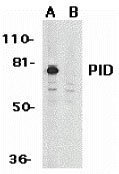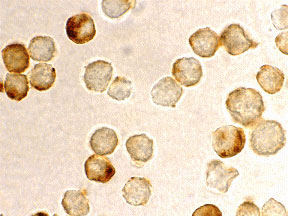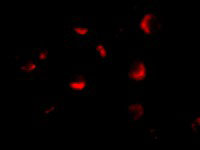PID Antibody
- 产品详情
- 实验流程
- 背景知识
Application
| WB, IF, ICC, E |
|---|---|
| Primary Accession | O94776 |
| Other Accession | AAG02241, 9931638 |
| Reactivity | Human, Mouse, Rat |
| Host | Rabbit |
| Clonality | Polyclonal |
| Isotype | IgG |
| Calculated MW | 75023 Da |
| Concentration (mg/ml) | 1 mg/mL |
| Conjugate | Unconjugated |
| Application Notes | PID antibody can be used for detection of PID by Western blot at 1 µg/mL. Antibody can also be used for immunocytochemistry starting at 10 µg/mL. For immunofluorescence start at 10 µg/mL. |
| Gene ID | 9219 |
|---|---|
| Other Names | PID Antibody: PID, MTA1L1, PID, Metastasis-associated protein MTA2, Metastasis-associated 1-like 1, MTA1-L1 protein, metastasis associated 1 family, member 2 |
| Target/Specificity | MTA2; PID antibody is predicted to not cross-react with MTA2 |
| Reconstitution & Storage | PID antibody can be stored at 4℃ for three months and -20℃, stable for up to one year. As with all antibodies care should be taken to avoid repeated freeze thaw cycles. Antibodies should not be exposed to prolonged high temperatures. |
| Precautions | PID Antibody is for research use only and not for use in diagnostic or therapeutic procedures. |
| Name | MTA2 |
|---|---|
| Synonyms | MTA1L1, PID |
| Function | May function as a transcriptional coregulator (PubMed:16428440, PubMed:28977666). Acts as a component of the histone deacetylase NuRD complex which participates in the remodeling of chromatin (PubMed:16428440, PubMed:28977666). |
| Cellular Location | Nucleus {ECO:0000255|PROSITE-ProRule:PRU00512, ECO:0000255|PROSITE-ProRule:PRU00624, ECO:0000269|PubMed:28977666, ECO:0000269|PubMed:33283408} |
| Tissue Location | Widely expressed. |
For Research Use Only. Not For Use In Diagnostic Procedures.
Provided below are standard protocols that you may find useful for product applications.
BACKGROUND
PID Antibody: The p53 tumor-suppressor gene integrates numerous signals that control cell life and death. Several novel molecules involved in p53 pathway, including Chk2, p53R2, p53AIP1, Noxa, PIDD, and PID/MTA2, were recently discovered. The transcriptional activity of p53 is modulated by protein stability and acetylation. PID/MTA2, also termed MTA1-L1, was found to be a subunit of nucleosome remodeling and deacetylating (NRD/NuRD) complex. PID/MTA2 modulates the enzymatic activity of the histone deacetylase complex and its expression reduces the levels of acetylated p53. Deacetylation of p53 by PID/MTA2 represses p53-dependent transcriptional activation and modulates p53-mediated cell growth arrest and apoptosis. PID/MTA2 is ubiquitously expressed in human tissues.
REFERENCES
Matsuoka S, Huang M, and Elledge SJ. Linkage of ATM to cell cycle regulation by the Chk2 protein kinase. Science 1998; 282:1893-7.
Tanaka H, Arakawa H, Yamaguchi T, et al. A ribonucleotide reductase gene involved in a p53-dependent cell-cycle checkpoint for DNA damage. Nature 2000; 404:42-9.
Oda E, Ohki R, Murasawa H, et al. Noxa, a BH3-only member of the Bcl-2 family and candidate mediator of p53-induced apoptosis. Science 2000; 288:1053-8.
Oda K, Arakawa H, Tanaka T, et al. p53AIP1, a potential mediator of p53-dependent apoptosis, and its regulation by Ser-46-phosphorylated p53. Cell 2000;102:849-62.
终于等到您。ABCEPTA(百远生物)抗体产品。
点击下方“我要评价 ”按钮提交您的反馈信息,您的反馈和评价是我们最宝贵的财富之一,
我们将在1-3个工作日内处理您的反馈信息。
如有疑问,联系:0512-88856768 tech-china@abcepta.com.























 癌症的基本特征包括细胞增殖、血管生成、迁移、凋亡逃避机制和细胞永生等。找到癌症发生过程中这些通路的关键标记物和对应的抗体用于检测至关重要。
癌症的基本特征包括细胞增殖、血管生成、迁移、凋亡逃避机制和细胞永生等。找到癌症发生过程中这些通路的关键标记物和对应的抗体用于检测至关重要。 为您推荐一个泛素化位点预测神器——泛素化分析工具,可以为您的蛋白的泛素化位点作出预测和评分。
为您推荐一个泛素化位点预测神器——泛素化分析工具,可以为您的蛋白的泛素化位点作出预测和评分。 细胞自噬受体图形绘图工具为你的蛋白的细胞受体结合位点作出预测和评分,识别结合到自噬通路中的蛋白是非常重要的,便于让我们理解自噬在正常生理、病理过程中的作用,如发育、细胞分化、神经退化性疾病、压力条件下、感染和癌症。
细胞自噬受体图形绘图工具为你的蛋白的细胞受体结合位点作出预测和评分,识别结合到自噬通路中的蛋白是非常重要的,便于让我们理解自噬在正常生理、病理过程中的作用,如发育、细胞分化、神经退化性疾病、压力条件下、感染和癌症。








